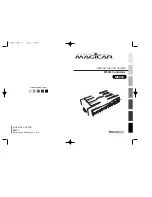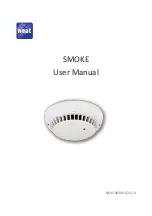
INTERCONNECTING SMOKE ALARMS
This smoke alarm offers a wired interconnection function.
Interconnecting smoke alarms can be linked together so that if one
alarm is activated all alarms linked on the circuit also sound.
NOTE: A 9V signal is applied to all interconnected wired smoke alarms.
The maximum wiring length is 150m between smoke alarms.
INTERCONNECTION WIRING DIAGRAM
(A)
Active
(E)
Earth Loop
(N)
Neutral
(I)
Interconnect
WIRED CONNECTION
1. Strip the active, neutral and interconnect (if used) wires back to the
strip length.
2. Connect the wires to the correct terminals on the base and ensure
terminal screws are fully tightened. Check all wires are secure and
not cross connected to either active or neutral terminations.
Ensure the terminal cover is closed to avoid contact with the active
terminal.
3. Screw the mounting base onto the ceiling using the supplied
fittings.
4. Clip the smoke alarm onto the base.
NOTE: The smoke alarm base will only close if a battery is
installed. Do not attempt to close without a battery installed.
5. Turn on the mains power and check the smoke alarm’s green and red
LED. Green LED should illuminate to indicate mains power is present.
Red LED will pulse every 40 seconds indicating correct operation
of the battery back up.
6. Press the Test/Hush button to check the smoke alarm is working.
Warning:
Installation is not complete until both LEDs are
functioning correctly and the alarm has been checked for
correct operation. Wiring must be installed in compliance
with local regulations.
Use a minimum of 1.0mm2 250V insulated wire for all wiring, including
interconnecting wiring.
Terminal Provisions: active, neutral, loop and interconnect terminals,
each accommodates 2x1.5mm2.
OPERATION AND TESTING
Smoke alarms are an important safety device in the home. It is import-
ant to check them regularly to ensure they are operating correctly.
Regular Mode
When there is no smoke present the green LED light remains on and
the red LED should flash every 40 seconds to show the alarm is active.
Alarm Mode
When the alarm detects smoke, the red LED will flash once per
second and the alarm will sound loudly. The flashing LED and alarm will
continue until the air is cleared.
Fault Mode
The alarm will generate a ‘chirp’ every 40 seconds indicating a fault.
TESTING YOUR SMOKE ALARM
It is recommended that you test your smoke alarm once a week to
ensure the smoke alarm is working correctly. Test by pushing the
test button on the cover. The alarm will sound if the alarm electronic
circuitry and battery are working. If no alarm sounds, the smoke alarm
has a defective battery, or another fault.
Warning:
Do not use an open flame to test your alarm. You
could damage the alarm or ignite combustible materials and
start a structure fire.
LOW BATTERY POWER
Should your smoke alarm have a low battery the unit will emit an
audible ‘chirp’ once every 40 seconds and the red LED light flashes
once at the same time. When this occurs you must replace the battery
immediately. Your smoke alarm will continue to warn of this low battery
for at least 30 days. However, failure to change the battery after this
time would mean your smoke alarm may have insufficient power to
alert you in a real fire situation.
Warning:
Your smoke alarm requires the battery to have
sufficient capacity of power to operate correctly.
SILENCE ALARM
If your smoke alarm emits the full alarm signal and you are not
testing the unit, the smoke alarm is warning you of a potentially
dangerous situation that requires your immediate attention. Only use
the alarm silence function after making sure that there is no ongoing
fire emergency situation.
Do not block the vents on the alarm or disable the smoke alarm in any
way as this will remove your protection.
Smoke alarms can sometimes react to cooking fumes or other non
emergency situations. In the event of a known false alarm your smoke
alarm can be temporarily silenced by pressing the test button. Your
alarm will automatically return to full sensitivity
within 8 minutes
.
1. Press and release the silence button, the alarm sound will stop.
2. Your alarm will silence and enter into a reduced sensitivity
reset cycle for approximately 8 minutes.
3. During the reduced sensitivity reset cycle, the red LED will flash
every 8 seconds indicating it is running in silent mode.
4.
Your alarm will automatically return to full sensitivity on
completion of the reset cycle and the red LED will revert to flashing
once every 40 seconds.
Warning:
Never ignore any alarm. Ignoring the alarm may result
in injury or death. If your smoke alarm activates and you are not
absolutely certain of the source of the smoke, get everyone out
of the house immediately.






















